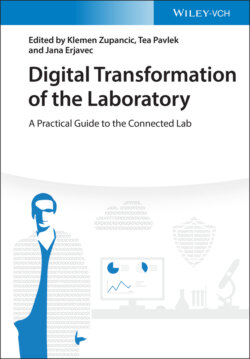Читать книгу Digital Transformation of the Laboratory - Группа авторов - Страница 14
1.2.1 People/Culture
ОглавлениеThe LotF and the people who work in it will undoubtedly be operating in an R&D world where there is an even greater emphasis on global working and cross‐organization collaboration. Modern science is also becoming more social [3], and the most productive and successful researchers will be familiar with the substance and the methods of each other's work so breaking down even more the barriers to collaboration. These collaborative approaches will foster and encourage individuals' capacity to adopt new research methods as they become available; we saw this with the fast uptake of clustered regularly interspaced short palindromic repeat (CRISPR) technology [4]. “Open science” [5] will grow evermore important to drive scientific discovery. This will be enabled through the increased use of new cryptographic Distributed Ledger Technology (DLT) [6], which will massively reduce the risk of IP being compromised [7]. The LotF will also enable more open, productive, collaborative working through vastly improved communication technology (5G moving to 6G) [8]. The people working in these labs will have a much more open attitude, culture, and mindset, given the influence of technology such as smartphones on their personal lives.
Robotics and automation will be ubiquitous, but with more automated assistance, the density of people in the lab will likely drop, allowing scientists to focus on key aspects and complex parts of the experiments. As a consequence, issues around safety and “lone working” will grow, and a focus on the interaction points which scientists have with automation will develop to ensure they are properly protected. For the few remaining lab technicians, not only will safe working become of increased importance, but the need for organizations to deliver a better “user experience” (UX) in their labs will become key to help them both attract the smaller numbers of more expert technicians and also retain them. The lab technician's UX will be massively boosted by many of the new technologies already starting to appear in the more future‐looking labs, e.g. voice recognition, augmented reality (AR), immersive lab experience, a more intelligent lab environment, and others (see later sections).
